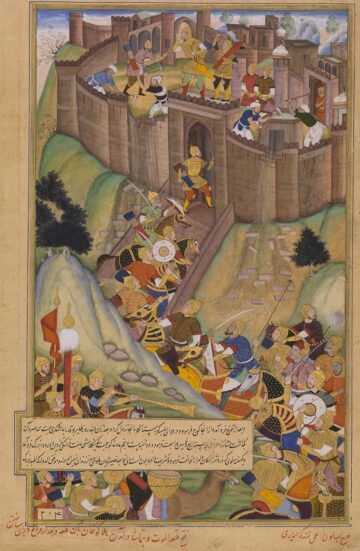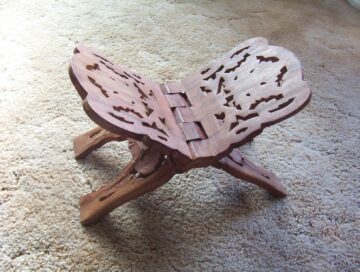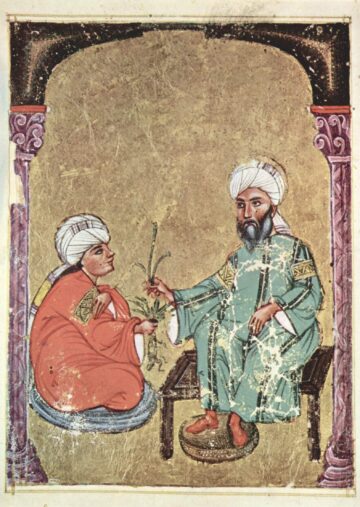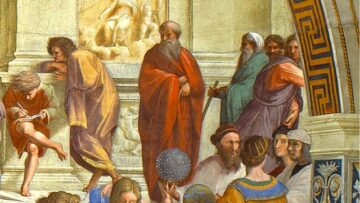Abstract: Seen from the vantage of the late twentieth century, relations between Muslims, Jews, and Christians look both better and worse than at any time in the past. In many parts of the world, Muslims are engaged in dialogue with Jews and Christians. Islam has become the fastest growing religion in the multiconfessional mix of (New World) religions, and Muslim leaders are now found alongside rabbis, priests, and ministers in many civic and religious organizations. Yet, at the same time, members of all three religions find themselves fighting one another in territorial and nationalistic wars that have taken on sectarian and religious overtones. In sorting out this mixed state of Muslim, Jewish, and Christian relations, it is important to keep in mind that all three religious groups point to the historical past to inform how they relate to the other groups. Interpretations of history, as well as sacred text and traditional doctrines, thus far have become the determining factors for how well or badly Muslims, Jews, and Christians interrelate. Throughout the article the author explains how understanding history and the ways history has been interpreted becomes, then, central in understanding the various claims made by the members of each religion.
Introduction
Relations among Muslims, Jews, and Christians have been shaped not only by the theologies and beliefs of the three religions, but also, and often more strongly, by the historical circumstances in which they are found. As a result, history has become a foundation for religious understanding. In each historical phase, the definition of who was regarded as Muslim, Jewish, or Christian shifted, sometimes indicating only a religious identification, but more often indicating a particular social, economic, or political group.
While the tendency to place linguistic behaviour, religious identity, and cultural heritage under one, pure definition has existed for a very long time, our modern age with its ideology of nationalism is particularly prone to such a conflation. Ethnic identities have sometimes been conflated with religious identities by both outsiders and insiders, complicating the task of analyzing intergroup and intercommunal relations. For example, Muslims have often been equated with Arabs, effacing the existence of Christian and Jewish Arabs (i.e., members of those religions whose language is Arabic and who participate primarily in Arab culture), ignoring non-Arab Muslims who constitute the majority of Muslims in the world. In some instances, relations between Arabs and Israelis have been understood as Muslim-Jewish relations, ascribing aspects of Arab culture to the religion of Islam and Israeli culture to Judaism. This is similar to what happened during the Crusades, during which Christian Arabs were often charged with being identical to Muslims by the invading Europeans. While the cultures in which Islam predominates do not necessarily make sharp distinctions between the religious and secular aspects of the culture, such distinctions make the task of understanding the nature of relations among Muslims, Jews, and Christians easier, and therefore will be used as an analytic tool in this chapter.
Another important tool for analyzing Muslim-Jewish-Christian relations is the placement of ideas and behaviours in specific temporal and geographic contexts. Visions of the past have had a strong influence on each of the religions, and none more strongly than Islam. Many Muslims have as keen an awareness of the events around the time of the Prophet as they do their own time. It is important for a practicing Muslim to know what the Prophet did in his relations with Jews and Christians as a means of shaping their own behaviour toward them. The Qur’an and the sunna of the Prophet are key guides for a Muslim in dealing with Jews and Christians, as they are in all areas of conduct. This same historical consciousness is also present among Jews and Christians, as each group makes claims for positions and status in Islamic societies. What is important to remember is that the historical interactions of Muslims, Jews, and Christians have resulted in each constituency being shaped, affected, and transformed by the others, such that it is difficult to imagine how each religion would be as it is without the presence and influence of the others.
The Foundational Period
When Prophet Muhammad was born in 570 CE , Arabia was deeply involved in the political, religious, and economic rivalries between the Byzantine and Sassanian Persian empires. Arabia was an important trade route for goods coming from the Far East and Africa and was strategically important for each empire’s defence. Arabs were recruited into the armies of both sides, providing horse and camel cavalries, and each empire had maintained Arab client states as buffers and bases of operation. Around fifty years earlier, the last Jewish kingdom in southern Arabia allied with the Persians and was defeated and replaced by a Christian Monophysite army from Abyssinia allied with Byzantium. According to early Muslim historians, this army, led by a general named Abraha, tried to invade Mecca in the year of Muhammad’s birth because the pagan Arabs had defiled one of the Christian churches in southern Arabia. Abraha and his forces were, however, defeated. Because the Abyssinians used war elephants for their attempted invasion, many think that this is the elephant referred to in the sura titled al-Fil in the Qur’anMuslims believe that the Holy Qur’an contains divine revelations to the Prophet Muhammed received in Mecca and Medina over a period of 23 years in the early 7th century CE. More: 105.
There were numerous Christian settlements throughout the southern and eastern parts of Arabia, but few in the Hijaz(Arabic; lit. ‘the barrier’). A region in the west of present-day Saudi Arabia along the Red Sea which includes some of the holiest sites and cities for all Muslims —…, the area of Muhammad’s birth. The Hijaz had numerous Jewish settlements, most of long standing, dating to at least the time of the destruction of the Second Temple in 70 CE. According to some scholars, the earliest Jewish presence in the Hijaz was at the time of Nabonidus, about 550 CE. The Jews in these settlements were merchants, farmers, vintners, smiths, and, in the desert, members of Bedouin tribes. The most important Jewish dominated city was Yathrib, known later as Medina, which featured prominently in Muhammad’s career. The Jews of the Hijaz seem to have been mostly independent, but we find evidence of their being allied with both Byzantium and the Persians. Some made the claim to be “kings” of the Hijaz, most probably meaning tax collectors for the Persians, and, for a variety of reasons, more Jews were loyal to Persian interests against those of the Byzantine Empire. Jews, as well as Christians, seem to have been engaged in attempting to convert the Arabian population to their religious and political views, often with some success. The loyalties of the Jews and Christians to one or the other of the two empires meant that Arab sources report that, at the time of Muhammad’s birth, some Meccans had abandoned Arabian polytheism and had chosen monotheism. In Arabic these individuals were referred to as hanif in a Jewish, Christian, or non-sectarian form. From Qur’anic and other evidence, it is clear that Meccans were conversant with the general principles of Judaism and Christianity and knew many details of worship, practice, and belief. During Muhammad’s formative and early adult years, the character of his birth city, Mecca, was very cosmopolitan.
When Muhammad had his first revelation in 610 CE, his wife Khadija sought the advice of her cousin, Waraqa ibn Nawfal, a hanif, learned in Jewish and Christian scriptures. Muhammad eventually declared that he was a continuation of the prophetic traditions of Judaism and Christianity, claiming that he had been foretold in Jewish and Christian scripture. A central doctrine of Islam places Muhammad at the end of a chain of prophets from God, starting with Adam and embracing the major prophetic figures of Judaism and Christianity, including Abraham, Moses, and Jesus. Denial of this central idea by Jews and Christians is said to be a result of the corruption of the sacred texts, either inadvertently or on purpose. This disparity of perspective underlies much of what Muslims believe about their Jewish and Christian forebears, and conditions Islamic triumphalist views about the validity of Islam against the partial falsity of the other two traditions.
The Qur’an and the Sira (the traditional biography of Prophet Muhammad) present ambivalent attitudes toward Jews and Christians, reflecting the varied experience of Muhammad and the early Muslim community with Jews and Christians in Arabia. Christians are said to be nearest to Muslims in “love” (Qur’an 5:82), and yet Muslims are not to take Jews or Christians as “close allies or leaders” (Qur’an 5:51). The Qur’an often makes a distinction between the “Children of Israel” (i.e., Jews mentioned in the Bible) and members of the Jewish tribes in Arabia during Muhammad’s time. This distinction is also present in the Sira and other histories. Some Jews are represented as hostile to Muhammad and his mission, while others become allies with him. The Qur’anic revelations that Muhammad received in regard to Christians and Jews seemed to correspond to the degree of acceptance that he was awarded by these two communities. Initially, Muhammad sought their acceptance, but when the leaders of the Christian and Jewish communities rejected him as a false prophet, he received revelations that commanded him to distance himself from them. In the “Constitution of Medina,” which Muhammad negotiated with the Ansar, the Muhajjirun, and the Jews of Medina, Jews were included in the Umma, the community, and were allowed freedom of association and religion in return for the payment of an annual tax. This agreement and the subsequent treaties negotiated by Muhammad with the Jews of Tayma, and other cities in the Hijaz, establish the precedent of symbolically including “People of Scripture” (Ahl al-Kitab) in the Umma. As the armies of conquest encountered communities of Jews, Christians, and Zoroastrians, the model of Muhammad’s accommodating behaviour extended the original notion to incorporate all these recipients of God’s revelation as Ahl al-Dhimma, or Dhimmi, protected peoples. There were fewer Christians in the Hijaz than Jews, so Christians are featured less prominently in the political history of the establishment of the Muslim community. Nevertheless, Muhammad had frequent contact with Christians from the southern areas of Najran and Ethiopia, disputing with them as he had with the Jews over matters of religious belief and practice. The traditions surrounding the sending of the Muslims to Ethiopia represent the ruler as seeing little difference between Islam and Christianity. The Qur’anic presentation of the life of Jesus and Christian belief shows that Muhammad and the early Muslims understood eastern Mediterranean Christian belief and practice, particularly if one acknowledges the importance of the “infancy” Gospels in Christian thought at the time. The Qur’an, however, denies the deity of Christ.
The death of Muhammad and the subsequent expansion of Islam out of Arabia brought about a definitive break with the Jewish and Christian Arab communities, so that subsequent relations were built on Jewish and Christian interactions with Muslims who knew the Prophet’s actions only as idealized history. During the first Islamic century, the period of the most rapid expansion of Islam, social and religious structures were so fluid that it is hard to make generalisations. Jews and Christians were theoretically expelled from Arabia, or, at least, the Hijaz, but later evidence shows that Jews and Christians remained for centuries afterward. As late as the eighteenth century, for example, Jewish Bedouins roamed north western Arabia, and Christian Arabs were found in numerous settlements throughout Arabia.
The Early Centuries of Muslim History
The period of the first caliphs and the subsequent era of the Umayyads was a time in which Muslims, Jews, and Christians negotiated the new power arrangements. The parameters of Dhimmi status were developed, and both head and land taxes were paid to the Muslim caliphs through representatives and not individually. For the Jews, the Resh Geluta or Exilarch was from the Rabbinic branch of Judaism, it became the dominant form, generally displacing other groups. Also, because Muslims expanded to include most of the world’s Jews in their polity, Rabbinic Judaism was able to develop its institutions within the context of the Islamic Umma. For the newly forming Islamic state, the loyalty of the Exilarch, and, by extension, the Jews, added legitimacy to Muslim claims to legitimate rule over its various non-Muslim populations. The interaction between Jews and Muslims thus produced profound effects on both Judaism and Islam.
Christians acted as physicians, architects, clerks, and advisors in the courts of the early caliphs. Greek and Coptic were the administrative languages for several centuries before Arabic became established enough to be the general medium of public discourse. Even the occasional uprisings against Muslim rule, as the Coptic uprisings of the early ninth century and the Jewish revolts against the Umayyads a century earlier, were local, over specific grievances, and not anti-Islamic as such. In fact, the Jewish revolt against the UmayyadsFirst major ruling Muslim dynasty that was based in Damascus (661-750)., driven, it seems, by messianic visions, was sympathetic to early Shia views and attempts to overthrow the last Umayyad caliphIn Arabic khalīfa, the head of the Muslim community. See caliphate..
The first two Islamic centuries was a time of translating Christian and Jewish scripture into Arabic, along with a vast body of commentary, particularly on biblical figures. Qur’anic tafsir (commentaries) became the repository of much Jewish and Christian tradition concerning such figures as Abraham, Moses, Solomon, Jesus, and others. The beginnings of Islamic theological speculation were stimulated by translations of Hellenistic thought from Aramaic, Coptic, Greek, and Syriac. One of the effects of this trend was to produce tension between those inclined toward greater cosmopolitanism of the intellectual and cultural heritage of Hellenism and those who felt that Islamic society should be centered only on the Qur’an and traditions from Muhammad, presaging the debates about the inclusion or exclusion of outside ideas. The resulting balance between religious and scientific learning became such a part of Islamic societies that even in periods of political fragmentation, Jews and Christians con tributed along with Muslims to the intellectual and cultural life of the Islamic communities.
The Medieval Period
In the western Islamic lands of the Iberian Peninsula and North Africa, Jews, Christians, and Muslims combined in a society that is often described by later historians with the adjective “golden.” The areas of poetry, music, art, architecture, theology, exegesis, law, philosophy, medicine, pharmacology, and mysticism were shared among all the inhabitants of the Islamic courts and city-states at the same time that Muslim armies were locked in a losing struggle with the Christian armies of the Reconquista. In the eastern Mediterranean, similar symbiotic societies could be found. The universities of al-Azhar in Cairo and Cordoba in Spain, both founded in the tenth century, followed the older model of the Bayt al-Hikma in Baghdad, as places of shared learning among scholars from the three traditions. Both the concept of these types of institutions of learning, as well as the learning itself they produced, had profound influence on European institutions of higher education and European scientific advancement. Within the intellectual circles of the Islamic world, Jews contributed and participated in this civilization through contact with Muslim philosophers and theologians, just as Muslims had from contact with Christians earlier. In the areas of commerce, world trade was dominated by trading associations made up of Muslims, Jews, and Christians from Islamic lands.
The twin attacks on the Islamic world in the Middle Ages by the Crusaders from the West and the Mongols from the East transformed Muslim attitudes toward the Dhimmi, and also the attitudes of the Jews and Christians in Islamic lands toward their relations with Muslim polity. Many Islamic areas develop in accordance with an already existing tendency to organize society along military lines. This becomes particularly true in areas where Turkic peoples take over the leading governmental and military roles. Converted by Sunni merchants and organised as military brotherhoods imbued with the spirit of military jihad, the Turks became the defenders of the Islamic lands. In their vision of society, the influence of Christians, Jews, and non-Sunni Muslim groups was circumscribed and made more rigid, but it was not eliminated. Muslim religious scholars used depictions of Jews and Christians found in the foundation texts as cautionary models for Muslims, but actual communities of Jews and Christians were treated with strict adherence to legal precedent. The Dhimmi had to wear distinctive clothing and badges to indicate their position in society, as did Muslims, as part of a general “uniform” indicating rank and status. Certain occupations became common for Jews and Christians, such as tanning, which was regarded as imparting ritual impurity to Muslims, and it became less common in this period to find Jews and Christians in the highest ranks of advisors to the rulers. Jews and Christians usually lived in separate quarters of cities, and, while they were inferior to Muslims in public and barred from riding horses or blocking the public way with religious processions, they lived autonomously with respect to their communal affairs. This autonomy, while somewhat protective of individuals, was to prove to have long-term consequences. Some Christian communities, caught in the middle of the conflict during the Crusades, actively expressed their loyalty to Rome and Constantinople and looked to the Crusaders as protectors of their interests. This association began a process of separation of some of these communities from the matrix of Muslim polity, and they became viewed as foreign by Muslims and themselves.
When Jews and Muslims were expelled from Spain in 1492 CE, the majority of Jews chose to move to Islamic lands, the area of the Ottoman Empire in particular. The Iberian Jews were so numerous, well educated, and prosperous, that Iberian Jewish culture often supplanted that of
the older Jewish communities, so that Sephardic became the general term for Jews living in Islamic lands. The trading and manufacturing skills and the capital of these immigrants to the Ottoman Empire provided much of the wealth for Ottoman expansion. Under the Ottomans, Jewish and Christian communities achieved the greatest degree of autonomy. Through the millet system, each community was distinct and responsible directly to the Sultan. The most famous intrusions into communal life occurred with the Ottoman institution of the Jannisary corps. Young Christian males were conscripted by the Ottoman military, trained as soldiers, converted to Islam, and placed in high positions in Ottoman administration. The process sometimes produced resentment among Christians, but some families actively sought to have a member chosen because of the possibilities of favours and preferential treatment later when the candidate assumed official duties.
The Modern Period
Napoleon’s invasion of Egypt in 1798 is generally regarded as the beginning of the modern period of the history of the Islamic Middle East and the beginnings of Western colonialism that was to encompass most of the Islamic lands in Asia and Africa. In reality, it signified the decline of Muslim polities against the economic and technological rise of Western Europe. By the eighteenth century, most Muslims found themselves living in or dependent on one of the three great Muslim empires: the Ottoman, the Mughal, or the Safavid Empire. All three empires were agrarian and relied on peasant labour for wealth, military strength, and products for worldwide trade. As Western Europe underwent the technological transformation usually termed the Industrial Revolution, with the concomitant rise of capitalism, it also underwent a social and religious revolution that placed great value on the individual and stressed individual effort and initiative. This reorganisation produced societies generally freed from family and clan constraints on labour allocation, rewards, and relations with governing powers such that the societies became more efficient in manufacturing and trading goods on the world market. In the worldwide competition, major areas of the Islamic world became providers of raw or only partially manufactured goods for the industrialized West. When the West sold back the manufactured goods, which often drove superior local goods from the market, it also exposed the Muslim customers to the ideals of the reorganised, industrialised society: individualised human rights, democracy, secularism and secular law, universal edu cation, science, nationalism, and the subordination of religion to the greater ideology of the nation-state. Western military and economic success proved attractive to many members of the Islamic states who sought to adopt Western ways as a means of securing part of this success.
In the Ottoman Empire, the British and French found Jews and Christians to be willing agents for their commercial activities, and the Ottomans, in turn, were pleased to employ the Dhimmi for these purposes as well. Many Jews and Christians sought to secure the benefits of Western societies for themselves and their offspring by asking for and getting Western protection,
passports, and, in some instances, citizenship. The Dhimmi often fell under the protection of the foreign powers. The increasing identification of Jews and Christians with non-Muslim powers served only to isolate these non-Muslims from the rest of Islamic society. Even in places where there was not an indigenous Jewish or Christian population to be exploited for economic gain, Western European powers arrived as colonialists with professedly Christian institutions, expectations, and ideologies. The British were able to separate Egypt from the Ottoman Empire and establish a protectorate in 1882, as they were able to put India under direct British rule in 1857. The French colonized Algeria in 1830 and Tunisia in 1881. The Dutch competed with the British for Southeast Asia, so that by the end of the nineteenth century, most Muslims were under Western political and legal influence. The secular legal systems devised in the West supplanted both Christian and Muslim customary and religious law, seriously challenging or eliminating the category of Dhimmi in those countries. The result was often a complete separation of Jews and Christians as groups from a relationship in law with Muslims.
The dissolution of the Ottoman Empire at the end of World War I, resulting in the creation of a number of small nation-states, resulted in a further separation of non-Muslims from Muslims. The ideology of nationalism reduced religion to the status as one of the components of a nation-state ideology. Education became Western, technological, and secular, further reducing religion to peripheral status. By the eve of World War II, most Islamic countries were prepared to overthrow colonialism and establish nation-states. When this happened after World War II, constitutions were modelled after such countries as Switzerland, the United States, and France, usually guaranteeing freedom of religion but providing no particular safeguards for religious expression. Other religious and ethnic groups also desired nation states. Nominal Christian states were formed in the Balkans, and the state of Israel was formed in the formerly British mandate territory of Palestine. The creation of the state of Israel in 1948 became a central focal point for Muslim-Jewish relations, which had steadily deteriorated since the end of World War I. The worsening conflicts in Palestine increased Jewish-Muslim conflict in the Arab states, where Jews were seen as both foreign and instruments of Western colonial designs. Within twenty years after the formation of the state of Israel, the majority of Jews living in Arab lands migrated to Israel, thus crystallizing the conflict in Palestine into a Jewish-Muslim conflict. Rulers in predominantly Muslim countries no longer had a constituent Jewish population. Jews were an abstract and hostile other, and Judaism, now increasingly identified with Zionism by Jews and non-Jews alike, was revalorized as the ever-present opposition to Muslims in Islamic history. This last notion, while having its roots in the foundation texts of Islam, was now abstracted in a way unlike any time in the past, and Jewish-Muslim relations took a new direction.
A common thread among many Islamic intellectuals concerned with the role and direction of Muslims in the postcolonial world is the role of the Jews in Islamic history. As mentioned above, the historical circumstances of a strong Jewish presence in the Hijaz during Muhammad’s time and the opposition of most of the Jewish tribes to Muhammad’s mission embedded numerous seemingly anti-Jewish statements into the early literature. For a few, in a quest to use the Islamic historical past to explain the present, the negative accounts of Judaism and Christianity became abstracted so as to conflate the past with the present Arab-Israeli and East-West conflicts; for example, biblical descriptions of Jews rebelling against God’s commands. Medinan Jewish opposition to the forming Muslim state and Israeli actions against Palestinians were read together as an eternal Jewish character, a view sometimes informed by Western anti-Semitic literature. The Egyptian intellectual, Sayyid Qutb’s article “Our Struggle with the Jews,” is one example, as are the views expressed by leaders of the American Nation of Islam.
Other Muslim intellectuals read the same foundation texts with an emphasis on the special relationship between God and People of the Book. While deploring the problems in Palestine, they separate the Arab-Israeli conflict from discussions about Jews and Christians. Some at al-Azhar in Egypt cite the Qur’an and sunna to support peace accords between Israel and the Palestinians, and Warith D. Muhammad, the son of Elijah Muhammad, in the United States has countered the anti-Jewish essentialist reading of the past with a Qur’anic-based message of mutual cooperation among Muslims, Jews, and Christians.
The Future
As Islam spreads to new places in the world, more and more Muslims are living as minorities in non-Muslim lands. This, too, has proved to be an intellectual challenge. Some Muslim states and organisations have tried to revive a notion of Dhimmi in reverse, seeking to be the protectors of the rights of Muslims in non-Muslim countries, as, for example, the Muslim World League and the Islamic Call Society. Linked to these ideas is the notion of the da‘wa, or the invitation to Islam to non-Muslims. The situation of minority Muslim communities in Africa, North America, and Asia, many of whom express Islam in ways different from those in Muslim-majority countries where Islam and indigenous cultures are intermixed, is prompting a form of inter-Muslim ecumenism parallel to the willingness of Muslims to par ticipate in the essentially ecumenical dialogues with Jews and Christians, the aims of which are understanding without attempts at conversion.
Discourse about Muslim-Jewish and Christian relations has been dominated in the first half century by the problems of forming new group identities after the dissolution of colonialism. Muslim, Jewish, and Christian communities have all suffered from conflicts pitting one group against another. As with any conflict, this period has produced considerable polemic. It has also produced positive calls for mutual respect and cooperation. The World Council of Churches has called for positive dialogue with Islam as part of its movement to reach out to people of all religions, and at the Vatican II Council, the Roman Catholic Church called on its members to esteem Muslims. Among synagogues in America, groups are expanding to promote Jewish-Muslim dialogue. As peace treaties are negotiated and conflicts are reduced to non-belligerency, members of all three religions find themselves in a position to build on the traditions of common heritage and common experience.
Armstrong, K. A History of God: the 4000 Year Quest of Judaism, Christianity and Islam. New York: A.A. Knopf, 1993.
Brinner W.M. and Stephen D. Ricks ed. Studies in Islamic and Judaic Traditions. Atlanta: Scholars Press, 1986. Brown Judaic Studies, no. 110.
Burrell, D. and B. McGinn ed. Creation in Judaism, Christianity and Islam. Notre Dame: University of Notre Dame Press, 1989.
Cohen, M.R. Under Crescent and Cross: the Jews in the Middle Ages. Princeton: Princeton University Press, 1994.
Cragg, Kenneth. The Call of the Minaret. New York: Oxford University Press, 1956.
Sandals at the Mosque. New York: Oxford University Press, 1959.
Cutler A. H. and H. E. Cutler. The Jew as Ally of the Muslim: Medieval Roots of Anti Semitism. Notre Dame: University of Notre Dame Press, 1986.
Ellis, Kail C. The Vatican, Islam, and the Middle East. Syracuse: Syracuse University Press, 1987.
Firestone, R. Journeys in Holy Lands: the Evolution of the Abraham-Ishmael Legends in Islamic Exegesis. Albany: State University of New York Press, 1990.
Goitein, S.D. Jews and Arabs: Their Contacts Through the Ages. New York: Schoken Books, 1955.
Hourani, A.H. Europe and the Middle East. Berkeley: University of California Press, 1980. King, N.Q. Christian and Muslim in Africa. New York: Harper and Row, 1971. Lewis, Bernard. The Jews of Islam. Princeton: Princeton University Press, 1984.
McAulliffe, Jane. The Quranic Christians: An Analysis of Classical and Modern Exegesis. New York: Cambridge University Press, 1991.
Newby, G. History of the Jews of Arabia From Ancient Times. Columbia, S.C.: University of South Carolina Press, 1988.
The Making of the Last Prophet. Columbia, S.C.: University of South Carolina Press, 1989. Parrinder G. Jesus in the Quran. New York: Oxford University Press, 1977.
Peters FE. Judaism, Christianity and Islam: the Classical Texts and Their Interpretation. Princeton: Princeton
University Press, 1990.
Stillman, N.A. The Jews of Arab Lands: A History and Source Book. Philadelphia: Jewish Publication Society of North America, 1979.
Studies in Judaism and Islam. Jerusalem: Magnes Press, 1981.
Wassenstrom, S. ed. Islam and Judaism: Fourteen Hundred Years of Shared Values. Portland, Or.: The Institute for Judaic Studies in the Pacific Northwest, n.d.
Watt, Montgomery W. Muslim-Christian Encounters: Perceptions and Misperceptions. London and New York: Routledge, 1991.
Author

Gordon Newby
The use of materials published on the Institute of Ismaili Studies website indicates an acceptance of the Institute of Ismaili Studies’ Conditions of Use. Each copy of the article must contain the same copyright notice that appears on the screen or printed by each transmission. For all published work, it is best to assume you should ask both the original authors and the publishers for permission to (re)use information and always credit the authors and source of the information.
© 1996 The Muslim Almanac
© 2006 The Institute of Ismaili Studies






